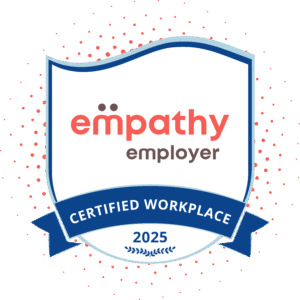Picture this – you are facing a stressful deadline. But then, your manager checks in, not just about the work, but how you’re doing. That small act of empathy – understanding your pressure and showing they care – makes a big difference. In today’s workplace, empathy isn’t just a soft skill; it’s a strategic advantage.
Why Empathy Matters
Empathy, the ability to see things from another person’s perspective and understand their feelings, is the glue that holds successful teams together. It fosters trust, encourages collaboration, and fuels innovation. Let’s break down why empathy makes good business sense.
Boosts Employee Experience:
When employees feel valued and understood, they’re happier, more engaged, and less likely to jump ship. It’s about creating an environment where people feel comfortable bringing their whole selves to work, knowing they’ll be supported, not judged.
Unlocks Teamwork:
Empathy breaks down silos and communication barriers. Team members become more willing to share ideas, offer constructive criticism, and support each other through challenges. This collaboration leads to better problem-solving and stronger results.
- Fuels Innovation:
Psychological safety, where people feel safe taking risks and admitting mistakes, is crucial for innovation. Empathy creates this safety net, allowing creativity to flourish. Teams feel empowered to experiment, knowing they have a supportive environment to learn and grow.
Improves Customer Experience:
Happy employees translate into happy customers. When employees feel valued and invested in the company’s success, they naturally provide better service and build stronger relationships with customers.
The Three Types of Empathy:
Cognitive Empathy:
This is the ability to understand another person’s thoughts and perspectives intellectually. Imagine a manager who listens patiently to a team member’s concerns and tries to see things from their point of view.
Emotional Empathy:
This is feeling what another person is feeling. It’s about acknowledging their emotions and validating their experience. Think of a colleague going through a personal crisis; emotional empathy involves offering a listening ear and genuine support.
- Compassionate Empathy:
This is the combination of understanding and feeling, coupled with a desire to help. It’s putting yourself in someone’s shoes and taking action to make things better. This might involve offering a flexible schedule to a stressed employee or brainstorming solutions to ease someone’s workload.
Building an Empathy-Rich Culture:
Creating a workplace where empathy thrives requires effort, but the benefits are worth it. Here are some practical steps:
Lead by Example:
Leaders set the tone. When managers demonstrate empathy through their actions, it sends a powerful message to everyone in the organization. This could be actively listening to concerns, offering recognition for achievements, or simply showing genuine interest in employees’ well-being.
Invest in Empathy Training:
Help your team members build their empathy skills. Training can cover active listening techniques, emotional intelligence practices, and conflict resolution strategies that focus on understanding others’ perspectives.
Recognize Empathy in Action:
Celebrate acts of empathy! Did a team member go the extra mile to help a colleague? Acknowledge it publicly and show your appreciation for their kind and considerate behavior. This reinforces the importance of empathy within the company culture.
Create Open Communication Channels:
Encourage open and honest communication. This allows employees to voice their concerns, offer suggestions, and share their experiences. Regularly gather feedback through surveys, focus groups, or one-on-one meetings. This helps identify areas where empathy might be lacking and allows for improvement.
It’s all about the people
In the end, building an empathy-rich workplace is about fostering a culture of respect, understanding, and human connection. It’s about treating employees not just as workers, but as whole people with feelings, needs, and aspirations. When you prioritize empathy, you create an environment where people feel valued, supported, and empowered to do their best work. This, in turn, leads to increased productivity, innovation, and ultimately, a workplace where everyone thrives.
Key Takeaways
- Empathy is essential for business success. It’s not a “nice-to-have” anymore; it’s directly linked to stronger teams, innovation, employee engagement, and ultimately, a thriving business.
- Empathy comes in different forms. Understanding the nuances between cognitive, emotional, and compassionate empathy helps us implement it effectively in the workplace.
- Building an empathy-rich culture is an ongoing process. It requires leadership commitment, training, open communication, and the celebration of empathetic actions.
- Prioritizing empathy benefits everyone. When we cultivate a workplace where people feel understood and valued, we see happier employees, smoother collaboration, a boost in innovation, and even better experiences for customers.






